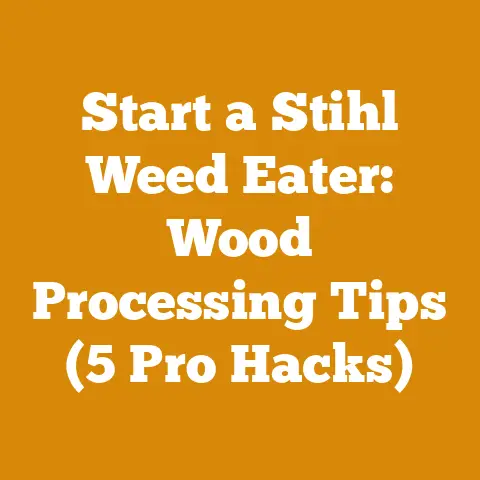How Do You Untangle a Chainsaw Chain? (Pro Tips for Woodcutters)
Okay, let’s get to it.
A tangled chainsaw chain can turn a productive day of woodcutting into a frustrating nightmare.
Believe me, I’ve been there – more times than I care to admit.
But the good news is, with the right knowledge and a little patience, you can untangle even the most stubborn chain.
This guide isn’t just about untangling; it’s about understanding your chainsaw and preventing future tangles.
Let’s dive in!
How Do You Untangle a Chainsaw Chain? (Pro Tips for Woodcutters)
Time is money, especially when you’re felling trees or splitting firewood.
A tangled chainsaw chain halts production and can be incredibly irritating.
But don’t reach for the bolt cutters just yet!
Before we get into the nitty-gritty, let’s define some key terms to ensure we’re all on the same page:
- Chainsaw Chain: The cutting component of the chainsaw, consisting of interconnected links with cutting teeth.
- Drive Sprocket: The toothed wheel that drives the chain around the bar.
- Guide Bar: The metal blade that supports and guides the chain.
- Green Wood: Freshly cut wood with high moisture content.
- Seasoned Wood: Wood that has been dried to reduce its moisture content, making it easier to burn and less prone to rot.
The Urgency of a Tangle
A tangled chain isn’t just an inconvenience; it can indicate underlying problems.
Is your tension too loose?
Are you using the wrong chain for the wood type?
Ignoring these issues can lead to more frequent tangles, premature wear, and even dangerous kickback situations.
Addressing the root cause saves time and money in the long run.
1. Safety First: Gear Up and Assess the Situation
Before you even think about touching that tangled mess, prioritize your safety.
- Wear Safety Gloves: Protect your hands from sharp teeth.
I personally prefer leather gloves with reinforced palms. - Eye Protection: Even if you were wearing it while cutting, ensure you still have eye protection.
Small debris can still fly around. - Disconnect the Chainsaw: This is absolutely crucial.
Remove the spark plug wire or, if it’s an electric chainsaw, unplug it.
You don’t want any accidental starts. - Assess the Tangle: Take a good look at how the chain is tangled.
Is it a simple twist, or is it deeply embedded in the wood or around the bar?
This will dictate your approach.
2. Clear the Immediate Area
Create a clean workspace.
Remove any loose wood chips, branches, or other debris that might be contributing to the tangle.
A clear area allows you to see the problem more clearly and maneuver the chain more easily.
3. Identify the Primary Obstruction
Pinpoint the main point where the chain is stuck or twisted.
This is usually where the chain is wrapped around the guide bar, drive sprocket, or a piece of wood.
4. Apply Lubrication
This is a trick I learned the hard way.
A little lubrication can go a long way in easing the untangling process.
- Chain Oil: Use standard chainsaw chain oil. Apply it liberally to the tangled areas.
- Penetrating Oil (Optional): If the chain is particularly stubborn, consider using a penetrating oil like WD-40.
Let it sit for a few minutes to loosen things up.
5. The Gentle Wiggle Technique
This is where patience comes in.
Avoid yanking or forcing the chain, as this can damage the links or even the guide bar.
- Gentle Movements: Start by gently wiggling the chain back and forth, trying to identify the direction that offers the least resistance.
- Work the Slack: As you wiggle, try to create small amounts of slack in the chain.
This slack will give you room to maneuver and unravel the tangle.
6. Utilizing Tools (When Necessary)
Sometimes, gentle wiggling isn’t enough. Here are some tools that can help:
- Screwdriver or Small Pry Bar: Use a screwdriver or small pry bar to gently separate the chain links where they are overlapping or caught.
Be careful not to damage the links. - Pliers (Needle-Nose): Needle-nose pliers can be helpful for gripping and manipulating individual links in tight spaces.
- Wooden Wedge: A wooden wedge can be used to gently separate the chain from the guide bar or wood without causing damage.
Important Note: Avoid using sharp metal tools like knives or screwdrivers directly on the chain teeth, as this can dull them.
7. Releasing the Tension
Often, the tangle is caused by tension in the chain. Try these techniques:
- Adjust the Chain Tension: Loosen the chain tension adjustment knob on the chainsaw.
This will give the chain more slack and make it easier to untangle. - Rotate the Guide Bar: If the chain is wrapped around the guide bar, try rotating the bar slightly.
This can sometimes release the tension and free the chain.
8. Unraveling the Loops
Once you’ve created some slack and identified the primary obstruction, start unraveling the loops one by one.
- Follow the Path: Carefully trace the path of the chain and identify where it crosses over itself.
- Reverse the Movement: Gently reverse the movement that caused the tangle.
If the chain is wrapped around the guide bar, try unwrapping it in the opposite direction.
9. Inspect for Damage
Once the chain is untangled, take a close look for any signs of damage.
- Bent or Broken Links: Check for any bent or broken links.
Replace any damaged links immediately. - Dull Teeth: Inspect the teeth for dullness.
Sharpen the chain if necessary.
A dull chain is more likely to get tangled. - Guide Bar Condition: Check the guide bar for wear or damage.
A worn or damaged guide bar can also contribute to chain tangles.
10. Reassemble and Test
Once you’ve inspected the chain and guide bar, reassemble the chainsaw and test it.
- Proper Tension: Ensure the chain is properly tensioned according to the manufacturer’s instructions.
Too loose, and it will tangle again.
Too tight, and it can cause excessive wear. - Lubrication: Make sure the chain oiler is working properly.
A properly lubricated chain is less likely to tangle. - Test Cut: Make a few test cuts to ensure the chainsaw is operating smoothly and safely.
Preventing Future Chain Tangles: Pro Tips
Prevention is always better than cure.
Here are some tips to minimize the chances of future chain tangles:
1. Proper Chain Tension
Maintaining the correct chain tension is crucial.
A loose chain is a tangle waiting to happen.
- Regular Checks: Check the chain tension frequently, especially when the chain is new.
New chains tend to stretch. - Temperature Considerations: Adjust the chain tension based on the temperature.
A cold chain will be tighter than a warm chain. - Manufacturer’s Instructions: Always follow the manufacturer’s instructions for chain tension.
Example: I once had a crew working on a large-scale firewood project.
They were constantly complaining about chain tangles.
After observing them, I realized they weren’t checking the chain tension frequently enough, especially after the first few cuts with a new chain.
Implementing a 15-minute tension check interval drastically reduced the tangle rate.
2. Chain Sharpness
A sharp chain cuts smoothly and efficiently, reducing the risk of binding and tangling.
- Regular Sharpening: Sharpen the chain regularly, ideally after every few hours of use.
- Proper Sharpening Technique: Use the correct sharpening tools and techniques.
A poorly sharpened chain can be just as bad as a dull chain. - Professional Sharpening: Consider having the chain professionally sharpened periodically.
They have the equipment and expertise to restore the chain to its optimal cutting condition.
3. Guide Bar Maintenance
A well-maintained guide bar ensures smooth chain movement and reduces friction.
- Regular Cleaning: Clean the guide bar regularly to remove dirt, sawdust, and debris.
- Deburring: Deburr the edges of the guide bar with a flat file to remove any sharp edges that could damage the chain.
- Lubrication: Lubricate the guide bar with chain oil to reduce friction.
- Check for Wear: Inspect the guide bar for wear or damage.
Replace it if necessary.
4. Wood Type Selection
Using the correct chain for the type of wood you’re cutting can also help prevent tangles.
- Hardwood vs.
Softwood: Hardwoods like oak and maple require a different chain than softwoods like pine and fir. - Green Wood vs.
Seasoned Wood: Green wood is more likely to bind and tangle the chain than seasoned wood. - Chain Pitch: Ensure the chain pitch is appropriate for the wood type and the chainsaw.
5. Cutting Techniques
Proper cutting techniques can significantly reduce the risk of chain tangles.
- Avoid Pinching: Use wedges or levers to prevent the wood from pinching the chain.
- Maintain a Steady Cutting Angle: Avoid twisting or forcing the chainsaw.
- Use the Correct Cutting Speed: Don’t force the chainsaw to cut too quickly.
Let the chain do the work.
Case Study: I once worked on a project felling large oak trees.
The crew was experiencing frequent chain tangles, especially when cutting near the base of the trees.
After analyzing the situation, I realized they were cutting too close to the ground, causing the chain to get pinched by dirt and debris.
By raising the cutting height and using wedges to prevent pinching, we significantly reduced the tangle rate.
6. Chainsaw Maintenance
Regular chainsaw maintenance is essential for preventing all sorts of problems, including chain tangles.
- Air Filter: Clean or replace the air filter regularly.
A dirty air filter can reduce engine power and cause the chain to bind. - Spark Plug: Replace the spark plug annually.
A worn spark plug can cause the engine to run poorly and increase the risk of tangles. - Fuel Filter: Replace the fuel filter annually.
A clogged fuel filter can starve the engine of fuel and cause it to stall. - Chain Oiler: Ensure the chain oiler is working properly.
A poorly lubricated chain is more likely to tangle.
7. Storage Practices
Proper storage of your chainsaw can also help prevent chain tangles.
- Chain Guard: Always use a chain guard when storing the chainsaw.
This will protect the chain from damage and prevent it from getting tangled. - Clean the Chainsaw: Clean the chainsaw before storing it.
Remove any dirt, sawdust, and debris. - Store in a Dry Place: Store the chainsaw in a dry place to prevent rust and corrosion.
Understanding Wood Types and Their Impact
The type of wood you’re cutting significantly impacts the likelihood of chain tangles.
Here’s a breakdown:
- Hardwoods (Oak, Maple, Hickory): Denser and more difficult to cut.
Require a sharp chain and proper cutting techniques.
More prone to pinching if not handled correctly. - Softwoods (Pine, Fir, Spruce): Softer and easier to cut.
Less prone to pinching, but can still cause tangles if the chain is dull or the tension is incorrect. - Green Wood: High moisture content makes it heavier and more prone to binding.
Requires extra caution and a sharp chain. - Seasoned Wood: Lower moisture content makes it lighter and easier to cut.
Less prone to binding.
Moisture Content Targets: For firewood, the ideal moisture content is below 20%.
This ensures efficient burning and reduces smoke.
I typically use a moisture meter to check the wood before stacking it for seasoning.
Tools of the Trade: Chainsaws, Axes, and Log Splitters
Let’s talk about the tools you’ll be using in conjunction with your chainsaw:
- Chainsaws: Choose the right chainsaw for the job.
A smaller chainsaw is suitable for limbing and small trees, while a larger chainsaw is needed for felling large trees.- Example: For felling trees over 20 inches in diameter, I recommend a chainsaw with at least a 20-inch bar and a 60cc engine.
- Axes: Used for splitting small logs and wedges.
A good splitting axe should have a heavy head and a long handle. - Log Splitters: Hydraulic log splitters are essential for splitting large quantities of firewood.
They significantly reduce the physical effort required.- Hydraulic Splitter Efficiency: A hydraulic splitter can split up to 5 cords of wood per day, compared to 1-2 cords with manual splitting.
Chainsaw Chain Specifications
Understanding the specifications of your chainsaw chain is crucial for optimal performance and safety.
- Pitch: The distance between three consecutive rivets divided by two.
Common pitches include 3/8″, .325″, and .404″. - Gauge: The thickness of the drive links that fit into the guide bar groove.
Common gauges include .050″, .058″, and .063″. - Drive Links: The number of drive links determines the length of the chain.
Example: A chainsaw with a 20-inch bar might require a chain with a 3/8″ pitch, .050″ gauge, and 72 drive links.
Strategic Advantages of Proper Techniques
Using proper techniques and tools offers several strategic advantages:
- Increased Efficiency: Reduces downtime due to tangles and other problems.
- Improved Safety: Minimizes the risk of accidents and injuries.
- Reduced Costs: Extends the life of your equipment and reduces the need for repairs.
- Higher Quality Work: Produces cleaner cuts and more uniform firewood.
Drying Methods: Green Wood vs. Seasoned Wood
Understanding the difference between green wood and seasoned wood is essential for firewood preparation.
- Green Wood: Freshly cut wood with high moisture content (often above 50%).
Difficult to burn and produces a lot of smoke. - Seasoned Wood: Wood that has been dried to reduce its moisture content (ideally below 20%).
Burns easily and produces less smoke.
Drying Times: The time it takes to season wood depends on the wood type, climate, and drying method.
Generally, it takes 6-12 months for hardwoods and 3-6 months for softwoods.
Drying Methods:
- Air Drying: The most common method.
Stack the wood in a well-ventilated area, off the ground.- Stacking Technique: I prefer to stack my firewood in rows, with spaces between the rows for air circulation.
This speeds up the drying process.
- Stacking Technique: I prefer to stack my firewood in rows, with spaces between the rows for air circulation.
- Kiln Drying: A faster method that uses heat to dry the wood.
More expensive but produces consistently dry wood.
Safety Considerations
Safety is paramount when working with chainsaws and wood processing equipment.
- Personal Protective Equipment (PPE): Always wear safety glasses, gloves, hearing protection, and sturdy boots.
- Chainsaw Safety: Follow the manufacturer’s instructions for safe chainsaw operation.
- Working Alone: Avoid working alone whenever possible.
If you must work alone, inform someone of your location and expected return time. - First Aid Kit: Keep a well-stocked first aid kit on hand.
- Emergency Plan: Have an emergency plan in place in case of an accident.
Costs, Materials, and Skill Levels
- Chainsaw: $200 – $1000+ (depending on size and features)
- Axes: $50 – $200
- Log Splitter: $500 – $3000+ (depending on size and power)
- Chainsaw Chain: $20 – $50
- Chain Oil: $10 – $20 per gallon
Skill Levels:
- Inspect Your Chainsaw: Check the chain tension, sharpness, and guide bar condition.
- Sharpen Your Chain: If the chain is dull, sharpen it using the correct tools and techniques.
- Practice Cutting Techniques: Practice proper cutting techniques to minimize the risk of pinching and tangles.
- Start Small: Begin with small projects and gradually increase the size and complexity as your skills improve.
- Seek Guidance: Don’t hesitate to seek guidance from experienced woodcutters or professionals.
Conclusion
Untangling a chainsaw chain doesn’t have to be a dreaded task.
With the right knowledge, tools, and techniques, you can quickly and efficiently resolve the problem and get back to work.
Remember, prevention is key.
By maintaining your chainsaw, using proper cutting techniques, and selecting the right chain for the job, you can minimize the risk of future tangles and enjoy a safe and productive woodcutting experience.
And always, always prioritize safety!
Now get out there and make some sawdust!






